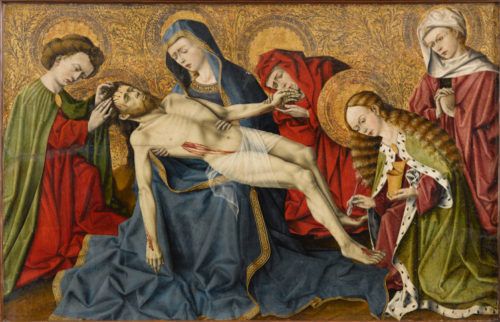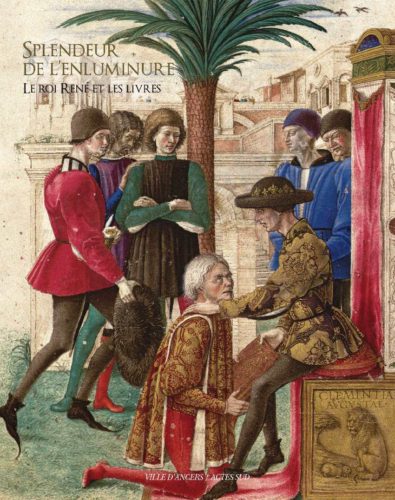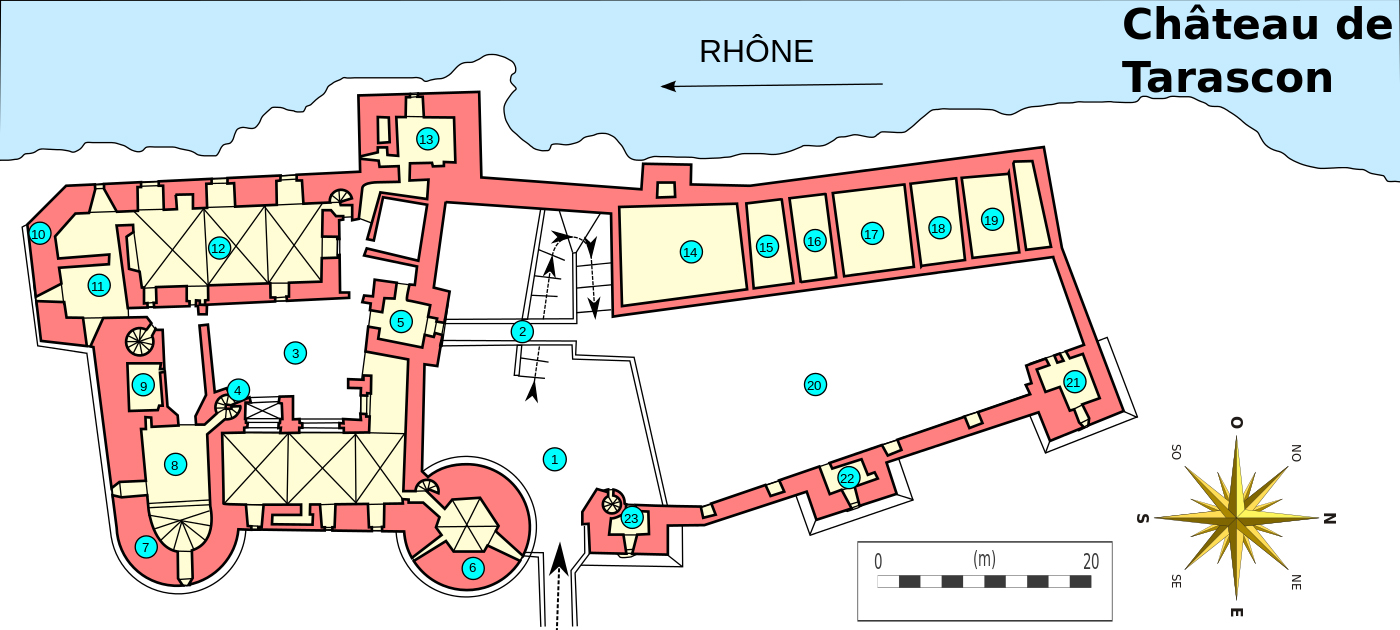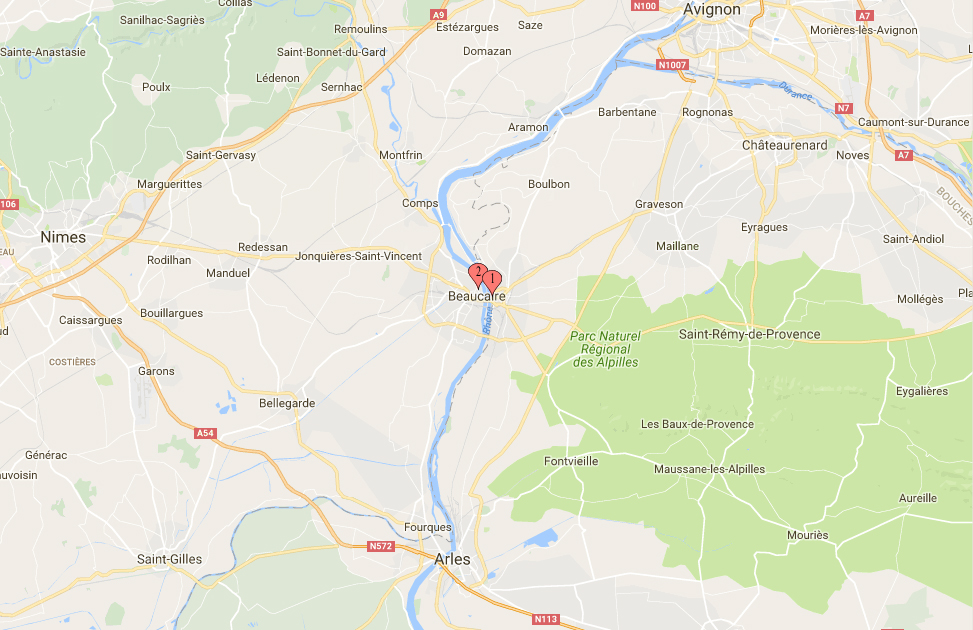Tarascon in the Bouches-du-Rhône is a small city in Provence situated on the banks of Rhône between Avignon in the north and Arles downstream. It is famous for its massive castle from ca. 1400
Tarascon was founded around 130 BC and developed into a trading station at a well marked crossing just before the river Rhône once more meandered into a wild, marshy delta to the north, where La Durance feed the mighty river. However, at Tarascon and Beaucaire – its sister city on the other bank – rocky outcrops seems to have provided a somewhat stable foothold on the banks as well as a safe place, where a crossing might be provided. Nevertheless, even today, the city as well as the plains to the north are occasionally threatened by floods, of which the last hit the city in 2003. It is a recurrent political issue to which extent the plains are sufficiently protected in view of the deteriorating climate. It is estimated that a flood event like that of 1856 have a 1% chance of happening every year. Today, the defence system may be in better order. Nevertheless, Tarascon was last flooded in 2003 and it is a recurrent worry for the people living at the Bouches-du-Rhône.
Earliest History

Luckily, help from God was soon at hand. According to legend, Martha of Bethany fled to Tarascon in AD 48 together with her brother Lazarus and sister Mary. There she defeated the river-monster, La Tarasque by taming him with holy water and a cross. The earliest Christian vestige inside the city is an oratory from the 3rd century with a tomb from the same time used as an altar. Legend has it, the housekeeper of God lived her life out there while keeping the people safe from flooding and other natural disasters.
Of more importance was probably that the Roman city of Ernaginum was located to the south east of Tarascon. Ernaginum was located at a juncture between the Via Agrippa (Arles-Lyons), the Via Aurelia (Aurelian way, from Rome by the coast) and the Via Domitia (from Rome to Spain). It was an important city whose economy depended mainly on these three major roads. In AD 480 Visigoths destroyed this city and the inhabitants were said to have fled to Tarascon, which at that point was probably more of a fortress than a town. In AD 500 Clovis is said to have visited the sanctuary of Sainte-Marthe where he prayed and received pardon. At this point he is also claimed to have accorded Tarascon certain privileges, which were later confirmed by his successors. Clovis is also supposed to have granted the town the land around in a three-mile wide circle. As written testimony to these commendable acts stems from the 13th century, it is probably not wise to attach too much faith in all this.
The facts also witness to a somewhat different story. In AD 590, a castle was built at Ernaginum stressing the fact that Tarascon was not in itself a terrible important settlement; lying as it did directly on the Rhône, the major highway for the Muslims in the 7th century. Nothing more is heard during the next period, when the Muslims conquered and held Southern France until they were defeated by Carl Martel at Poitiers in 732. After the death of Charlemagne in 814, Province fell to Lothar’s part, which was bordered by the river Rhône. This meant that Tarascon acquired the status of a frontier town based at one of the more important of the existing river crossings. On one site ruled the suzerainty of France on the other that of the Empire. Such was the case until Province fell to France at the death of the last count in 1487. During the next centuries – from the 9thto the 10th – pirates (Greeks, Vikings, Muslims) repeatedly sailed up the Rhône, pillaged the towns and cities and took slaves. At this time Tarascon was mentioned in the sources as “Tharaconis Villa” – in all probability a fortified settlement consisting of a village with a church (Sainte-Marthe).
AD 994 – 1233

Between 994 and 1010 Roubard, the second Count of Provence had the first castle constructed. The main object was to build a fortification guarding Provence against warring parties from across the river. Of special concern was probably also the possibility for the enemy to sail up the Brassiere du Rhône, running north of the town, thus entering from the “back”. This first castle was built at the same location as the present and archaeological information about its layout is sorely lacking. Around the same time a harbour is mentioned making it possible to extract toll.
During this period it is complicated to make a distinction between the castle, the outer court and the fortified town, which was walled in from 1166 to 1176. Here, the retainers belonging to the household of the Count built their city houses; some of these may have been fitted with crenelated towers
Around this time, the town was divided into three districts: the market with a fish market, now Rue Poissonnerie (Gàche du Marché), the Gàche du Chateu, where the lord’s retinue lived and the Gaché du Pin of which not much is known. Outside, to the east, was found the Faubourg du Pré, which belonged to the Count. At this time the later districts in the city, the Condamine and the Vigne were still located outside the walled town. They were primarily used as garden districts. To the north of the Brassiere lay the Island of Jarnègues, a kind of no-mans-land used for concluding treatises with France. Here the Templars had a house until they moved into the city of Tarascon in 1220 (in the Quartier de la Condamine)
The church of Sainte-Marthe is mentioned in 1107, but the present Romanesque church was not built before 1125 – 50. Of the old church only minor parts, mainly in the crypt and the impressive portal are still in existence. This new church was consecrated in 1197.
In 1096 a church was built together with a hospital, Saint Nicholas, in the Pré. Together with a cemetery this was destined to cater for the growing number of pilgrims. It was built by the countess Douce in order to commemorate her her son, Bertrand. The hospital was built outside the city to the east at the location of what was probably a manorial site belonging to the counts (but outside the walls).
In the surrounding countryside at least eight chapels have been identified at this point. Of these, several are still existent: the Chapel of Notre-Dame de Lansac (1009 – 1015), The Chapel of Saint-Victor c. 1054, the Chapel of Saint-Gabriel (mentioned in AD 858) and the Chapel of Saint-Etienne. It is around the same time the Abbey of Saint-Michel de Frigolet to the north of Tarascon was being rebuilt.
In the 13th century, the city of Tarascon was at the centre of an uprising fought by the burghers against the counts and nobles and in 1232 the castle and its environs were laid waste. This caused an imperial intervention in 1233, which organised an extension of the fortified district as well as a renovation of the walls of the city. At the same time a rebuilding of the castle and the near precinct was initiated. Around the same time, the Dominicans and the Franciscans build friaries at the Island of Jarnègues.

AD 1246 – 1400

In 1246 the brother of Saint-Louis, Charles of Anjou, married Beatrice of Provence, daughter of the Count of Provence, Raymond Berengar IV. Through her, he became count of Province and Forcalquier. Next year he was made Count of Anjou and Maine. On the basis of this he was able to forge a remarkable career as King of Albania, Naples, Sicily and (by purchase) king of Jerusalem. After his takeover, the role of Tarascon changed.
Charles of Anjou is known as a heavy-handed administrator and the formerly “free” towns of Provence underwent intensive inquests in 1252 and again in 1278. The aim was to make the rich region pay for his territorial ambitions elsewhere. At the same time the former recurring animosities between France and the Counts of Provence melted away. This created a sounding board for the town of Tarascon as a lively trading port on the river Rhône consisting of one of the important arteries up to the new Papal centre in Avignon (from 1309) and to and from interior France.
However, it is important to note that the region was not yet legally subsumed by France. For instance this meant that a considerable number of Jews were able to take refuge after the banishment of the Jews from France in 1306. It is estimated that Jews made up more than 10% of the population. An important role, they filled was to be responsible for the extraction of toll, which constituted an important income for the comital family as well as the local elite.
During this period the castle was renovated in 1290 – 91, probably acquiring the present layout. A garden was apparently laid out as well as room for residences of servants and courtiers. It is during the same period (1251) a baton-bridge is built across the Rhône linking Tarascon with Beaucaire on the other side of the river.
Later houses were built near the bridge, which were obliged to pay taxes; it is probable, the houses were built on the Isle de la Roi in the middle of the Rhône. Some time in the 14th century, this bridge seems to have been washed away. In 1426 a bark is mentioned ferrying passengers across. No new bridge seems to have been built until the 17th century.

In the city, the main change consisted in the takeover of the possessions of the Templars by the Trinitarian Order and a rebuilding of their house in 1330 by the Trinitarian Order. Later, in 1345 the districts of le Vigne and the Condamine were walled in. This was the final extension of the old town. It is generally thought that this extension had to do with the need to accommodate a growing population working in the shipping industry, hauling barques up river against the stream. At the same time, the suburbs were razed to the ground in order to prevent attackers from sheltering there.
However, the good times soon came to an end in the 14th century. Worsening climate, famines, pestilences and warring caused a significant demographic depression and economic deterioration. Nevertheless, the period saw some new constructions being undertaken. From 1358 – 61 a new Benedictine convent was built next to the church of Sainte-Marthe and in 1370 the castle was once more undergoing reconstruction.

Finally the tipping point came after 1380, when the citizens of Tarascon engaged in civil war. Tarascon had been one of the towns and cities in Provence, which had entered into the “Union d’Aix” in 1382. The aim was to establish a common front against the takeover of the comitat by Louis I of Anjou. The towns and cities supported the rival claims of Charles Duras, who was warring with Louis about the kingdom of Naples. In 1384 Louis died and his son and heir was only 7 years old. This should have ended the matter, but in 1386 Charles Duras was murdered in Hungary, leaving the way open for the mother of Louis II to reclaim his inheritance, including Provence. In 1387 the new prince of Provence made his entry into the region together with his mother, subsequently quelling a series of violent riots. Tarascon was one of those towns, which gave in the last after having destroyed the castle completely.
In the following years, the ducal grip on the town slowly tightened. Up until the 1370s a mixture of nobles and citizens had governed the city, but after the end of the revolt the oligarchy became even more prominent; no more than forty persons seemed to man the governing body. Also, the income squeezed out of the town – mainly consisting in toll paid on people and goods shipped up, down, or across the river grew. Even though Tarascon had fewer than 5000 inhabitants at the end of the fourteenth century, it still provided the Count with the fourth highest income. Even though a treaty had been signed in 1387 according to which the castle in the town should not be rebuilt, everybody sailing up the river Rhone today will know that this particular treaty was not kept. In ca. 1400 Louis II launched the monumental rebuilding, which his two sons, Louis III and René of Anjou, followed up. Today the castle remains one of the more impressive sites in Provence and witness to the late medieval princely life at the court of René of Anjou.
René of Anjou

René of Anjou was born in Angers in 1409 as the second son of the Duke of Anjou, King of Sicily and Naples. In his youth, he was known as the Count of Guise. Through his marriage and the inheritance of his mother, he became heir to the Duchies of Bar and Lorraine in 1419. In 1435 at the death of his brother, he succeeded to the Duchy of Anjou and the county of Maine. In 1438 he set sails for Naples, but he lost that part of his inheritance effectively in 1441. While pursuing his inheritance, the rest of his life was effectively spent as confidante of the French King. However, in his later years he also devoted time to composing poetry, painting miniatures, gardening, raising animals and writing religious treatises. Due to his numerous and fluctuating claims to diverse titles, he frequently changed his coat of arms.
In his later life, the Castle at Tarascon was his one of favourite residences, competing only with that in Aix, where he possessed a beloved garden. Here, at Tarascon and Aix he organised famous tournaments, wrote his “Livre des Tournois” and a religious treatise, “La Mortifiement de vaine plaisance”, and held banquets for prominent guests like the French king and his retinue of nobles.

Paris, Bibliothèque nationale de France, français, 1974
One of the more famous feasts at his court was the “Pas de Tarascon”. This took place during his stay in Tarascon from May 17th to July 2, 1449 and was probably meant as a celebration of the completion of the castle. It began on the 3rd of June, when the king and queen mounted a scaffold to the sound of tambourines and trumpets. It began with a tilt between Pierre Carrion and Philippe de Lioncourt on the 3rd of June and then continued for three days with numerous jousts, masques and plays of different kinds. One of the fascinating elements was “Pas d’Armes” or Passage of Arms. This would involve a group of knights staking out a travelled spot – in this case the bridge to the Island of Jarnègues, Here they would let it be known that any travelling knight wishing to pass must either fight or be disgraced. In this particular instance they were defending Isabelle de Lenoncourt, who was dressed up as shepherdess in a grey damask dress and a red bonnet and carried a silver crook, while the rest of the party dressed up in grey as if they were shepherds; hence the name of the event: Pas d’armes de la bergiere, as it was called in a poem written by the French Seneschal, Louis de Beauvau. According to his description the pas des armes began when she entered on horseback followed by the two enrolled shepherds with their sheep and escorted by the company, who was going to defend her. A charming illustration shows her sitting in a rustic bower, decorated with flowers and beneath two shields – one was black and another white. A fight then ensued where the aim was for the attackers to enter her bower and get to touch the shields. This tableau and others of the same ilk were staged in front of a public consisting of people from both town and countryside. One wonders, what ordinary people thought, when the royals and their noble retinue mimicked their lives. Later in the evening the noble company would withdraw to the castle, presumably to enjoy music, singing and dancing with the people perhaps spending the evening together, downtown.
The Castle

The castle as it stands today is empty of any of its former glories – furniture, art, textiles, and treasures like flacons, majolica, glassware, books and precious vessels made of gold or silver.
Unfortunately, the empty space has inspired local artists to get occasional permission to fill the rooms with installations of various sorts. In order to imagine what life was like in King René’s time we are however fortuitously in possession of several full inventories, which were drawn up in the 15th century and which have been used to provide a sense of what life was like in his castle in the time of king René.
The castle is visited by crossing the bridge from the east entering the middle courtyard. From here steps lead to the lower court with the service quarters built to the north and the garden to the south. The garden was reconstructed in 1993 with the use of inspiration from medieval tapestries. In summer it yields a numerous apples, pears and figs. In 1476 he had aviaries set up with turtledoves. quails and an ostrich.
In the wing to the west, overlooking the river, were located the larger kitchen, the pantry, the wine “cellar”, the bakery, a locale for preparing sauces and finally a room for keeping and serving fruits. The inventories lists numerous copper cooking pots, spits, dressers, tables and trestles. Nowadays it holds the ticket office, the shop, toilets and an apothecary from the 18th century.

Back across the middle courtyard along a bridge, the visitor enters the upper court, which is surrounded by the seigniorial quarters of the Princes of Anjou. The court d’honneur served as the central meeting ground for the king and his retinue together with the porch and the gallery. From here they could also enter the great chapel in order to participate in the religious services together with the royal family.
To the east were the royal apartments. At the rez-de chaussée was located the great hall, the salle des festins or “magna Aula”. To the south of this was located a number of small rooms used as the royal kitchen with its own wine cellar. Above that – in the corner between the south and west wing was the private royal chamber with his “great retreat” on top. From here the king could enter his private chapel 8the upper chapel).
When entering the court d’honneur it was possible to move forward and mingle with people, who had come for general audiences. However, another option was to go to the right and enter the grand “salle des festins”. This is a formidable hall measuring 20 metres. Here banquets were organised and in 1457 three dining tables, two chests, benches and seven stools with backrests for seating were listed plus ten trestles, a dresser and two iron andirons. To the south was the small kitchen with a bread oven, meant to serve the king and his table. presumably the king was seated at this end with his back to the blazing logs in the great fireplace, which can still be seen. Here, he might also enjoy the superb view across the Rhone with its busy traffic of small boats ferrying goods up and down the water. When tables were set the king probably used his imported Majolica and fine painted glass as well as numerous treasures from the Levant.

On the first floor, above the “Salle des Festins”, was the “Salle d’apparat” with a wooden ceiling, decorated with depictions of imaginary animals, characteristic of medieval bestiaries. This was the grand audience room, used for dinners with embassies or other official gifts. However, it was probably also used as the more private dining room for the royal family and its closer retinue.
Next to this room was the king’s chamber fitted with a bedstead, with a cover decorated with leopards and lions – probably designed to remind of his “lost” kingdoms of Naples and Sicily – a bed warmer, a chandelier and a hanging depicting the story of Bertrand du Guesclin. He was one of the great heroes from The Hundred Year’s War and his victories were also celebrated in a number of tapestries made for the Duke of Burgundy in the 14th century [1]. Perhaps René’s tapestry was a prized gift?
Onto the next floor we find the “grand retreat” of king René with a mantelpiece and a restored ceiling. This was connected to the kings writing chamber. Again, we are offered a view into a sumptuous room furnished with a writing desk covered with red fabric and a footrest made of pine. Here was also a large ewer, a globe, a horse tooth case, and iron compass, a quiver made from boiled leather, a Moorish stirrup, a small horn, a green lizard skin whistle and other such odd paraphernalia. Here – or nearby – he probably kept his large collection of books among which could for instance be found 24 written in Arabic as well as numerous books on geography, history, antiquities and science. Elswhere, we know he owned an astrolabe, but he also dabbled in astrology. One of the curious phenomena of his time is the splendid collection of exotics, which belonged to the king’s household.

Next to it a huge garderobe was located used for storing tapestries chests, benches, covers etc. Finally, on the roof was the terrace offering a fine view onto the Rhône. Other chambers of the south side offered living quarters for the rest of the royal family. Among these rooms was a bathroom with heated floor.
All this was ostensibly paid for by the income, which was not least derived from the toll paid by tradesmen charting ships sailing up and down the Rhône. Of this income, three quarters fell to the king in his castle. Furthermore, we know that while the level of tolls declined slightly from 1252 to 1298, it rose in significance in the period after 1387. There is no doubt, the Counts of Provence increased their income from the tolls in the 14th century despite the economic and demographic downturn. This was probably due to the importance of the Avignon Papacy. To what extent The Good King Réne was able to keep up this specific income from Tarascon during the later part of his reign is another matter.
However, there is no doubt Tarascon was worth defending in the 15th century. As it stands today, the magnificent castle is the best witness to what was by all accounts a thriving and lively community.
NOTES:
[1] Tapestry in the Renaissance: Art and Magnificence.
By Thomas P. Campbell, Metropolitan Museum of Art 2002, p. 16 – 17
SOURCES:
Zppaup de Tarascon. Rapport de Présentation. 2007
King René’s Chateau at Tarascon
By Robin Françoise
Patrimoine 2006
ISBN-10: 2858229139
ISBN-13: 978-2858229130
SEE MORE:
READ MORE:
Michel Hebert:
Tarascon au XVIe Siecle
Edi Sud, Aix 1979
ISBN-10: 2857440332
ISBN-13: 978-2857440338
Tarascon au XV Siecle
By Claude Roux
Aix 2004
Thèse de doctorat
Université Aix-Marseille 1
(Unpublished)
Splendeur de L’Enluminure. La Roi René et les Livres.
By Marc-Edouard Gautier
Ville d’Angers/Actes Sud 2010
ISBN-10: 2742786112
ISBN-13: 978-2742786114
 René d’Anjou, écrivain et mécène (1409 -1480).
René d’Anjou, écrivain et mécène (1409 -1480).
Ed. by Florence Bouchet.
Brepols 2011
ISBN-10: 2503533507
ISBN-13: 978-2503533506
Les Arts et les lettres en Provence au temps du roi René
By Chantal Connoche-Bourgne
Publications de l’Université de Provence, 2013
ISBN: 978-2853998895
Le Roi René dans tous ses États.
Ed by Jean-Michel Matz et Elisabeth Verry,
Editions du Patrimoine Centre des monuments nationaux 2009
ISBN-10: 2757700693
ISBN-13: 978-2757700693


